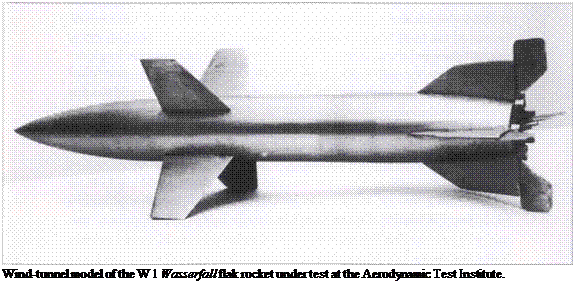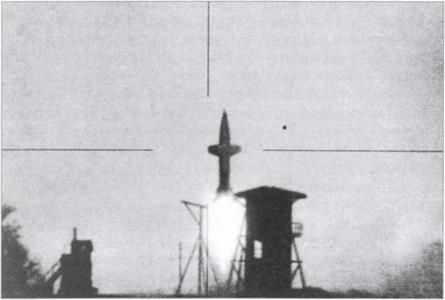Wasserfall

Towards the end of the war the Peenemiinde EV Wasserfall design was considered to have the best chance of winning back for Germany air supremacy over the Reich. It was a remote-controlled, single stage, liquid-fuel supersonic rocket designed to engage enemy aircraft at the highest altitudes. Its wings and fins had a cruciform arrangement and it was fired vertically. Simultaneous with work on the single-stage variant W 1 – also known as С 1 – at the beginning of 1942 work was started on the two-stage C 3 version. On 15 June and 12 July 1942 OKL placed orders with Rheinmetall to handle the C 3 development. As the results promised early military use, on 12 March 1943 series production was
|
Firing of the Wasserfall prototype at the north tip of Usedom island. |
scheduled for mid-1944. From June 1944, 250 would be turned out monthly, from September 1944 1,000, from December 2,500, and from March 1945 7,500 monthly, according to the RLM and Armaments Ministry figures. Only two experimental rockets, W 1/1 and W 1/2 would be built of the С 1 version, the C-2 version would generate all further test rockets and the first operational series-produced rockets. Apart from difficult technical problems which remained to be resolved, there was little capacity to produce the C 2, too little by way of raw materials, and above all too litde space. It was therefore impossible to predict the date when the Luftwaffe would have its effective defence against Allied bombers. To find a useful solution, in July 1943 it was decided to equip the first 1,000 rockets with control-stick steering and then 5,000 with radio control.
Testing of Wasserfall proceeded only slowly. In November 1943 it was announced that the first two experimental rockets would be fired from Peenemunde in March, five others in June and another 20 by the end of September 1944.100 were to have been produced by the beginning of 1945. In January 1944 it was expected that the shortage of graphite from the third quarter of the year 1945 would result in rocket production being severely cut back. This would be accompanied by procurement problems, serious transport and delivery hold-ups and not least bureaucracy.
On 8 January 1944 Wasserfall W 1/1 exploded on the ground during a test. In February 1944 there were further problems with the fuel regulator and combustion chamber valves. Despite all difficulties W 1/2 was fired successfully
on 29 February 1944. In order to skirt the materials bottleneck, on 17 April 1944 the number of experimental rockets required was reduced. After 80 for testing and 20 for ground and materials investigation, 400 C 2s were to be produced as soon as possible for operational testing. In June 1944 the first two Wasserfall of the second series (W 2) were fired from Test Stand IX on Usedom Island, Peenemiinde.
Operational use against Allied aircraft was still a distant prospect. Other C 2 starts, some disastrous, were made in September from Test Stands P II, P II South and P IV, but on 9 October 1944 Wasserfall C 2 was declared ‘risk – free’since the majority of 110 test starts had proceeded without problems. By 12 November there had been 14 more firings to test missile stability, flight control and the rocket motors.
Development of the flight control system was considered complete by the beginning of 1945. In February the motor was certified reliable and production was listed for the end of February, or the latest at the beginning of March, in the bombproof tunnels at Kohnstein/Nordhausen. By 18 February, 28 Wasserfall rockets had been fired, all fitted with remote control except for the basic prototype. Five of these were blown up at take-off or shortly after. Despite this, the Emergency Programme of 13 March 1945 scheduled the further development of 20 new A 10 variants monthly from April 1945, far too few to bring about any change in the air war over the Reich.











